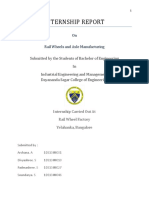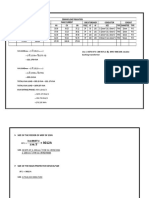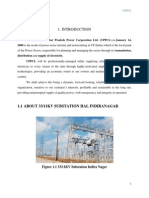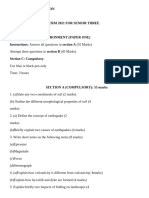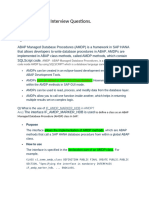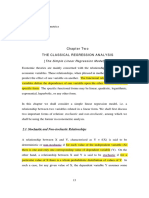Modellinag & Simulation With MiPower
Uploaded by
Akshay SharmaModellinag & Simulation With MiPower
Uploaded by
Akshay Sharma1
Algorithm of Load Flow Simulation and Fault Analysis using MiPower Software
Akshay Sharma Scholar M.E., Department of Electrical and Electronics Engineering, NITTTR, Bhopal, India akshaysharmagwl@gmail.com Laxmikant Nagar Scholar M.E., Department of Electrical and Electronics Engineering, NITTTR, Bhopal, India lk.nagar063@gmail.com
Abstract - This paper focuses on load flow analysis in an electrical power system. A load flow analysis program using MiPower software has been developed using a fast decoupled load flow algorithm based on a Y bus admittance matrix to determine operating parameters of system bus. A network of 6 bus system is considered as a test case. The Simulink model developed using MiPower software results in fast iterative process. GUI (Graphical user interface) will be provided with the program as the component of the tool box. Fault analysis is carried out on one of the transmission line of 6 bus systems for frequently occurring single line to ground fault to observe the operating parameters of the system under consideration in terms of AC voltage, AC current and AC power waveform at the grid before and after the occurrence of Single line to ground fault. Key Words: Load flow analysis, MiPower, Single line to ground fault, Fault analysis, operating parameters
transmission line of 6 bus systems for frequently occurring single line to ground fault. The simulation results and reports are analyzed in section 5.
1.1SYSTEM DESCRIPTION
Figure1 shows a single line diagram of a 6-bus system with two identical generating units, five transmission lines and two transformers. Per-unit transmission line series impedances and shunt susceptances are given on 100 MVA base, generator's transient impedance and transformer leakage reactances are given in the accompanying table1.1
I. INTRODUCTION
Load flow studies are used to ensure that electrical power transfer from generators to consumers through the grid system is stable, reliable and economic. It deals with the flow of electrical power from one or more sources to loads consuming energy through available paths. Unlike the traditional circuit analysis, a load flow study usually uses simplified notation such as a one-line diagram and per-unit system. Considerable research has already been carried out in the development of computer programs for load flow analysis of large power systems. However, these general purpose programs may encounter convergence difficulties. There are many solution techniques for load flow analysis. The solution procedures and formulations can be precise or approximate. In this paper we have attempted Fast decoupled load flow analysis to build a power system using the random data taking care of all the parameters required for the simulation and analysis. We have modeled an 11kv generation, 110kV transmission 6 bus grid using MiPower software. We begin with description of 6 bus system under section 1.1 and data collection and methodology required for modeling is discussed in section 3 and in section 4, Load flow study is carried out using Fast decoupled load flow analysis and voltage profile of buses are analyzed. In addition to load flow analysis, Our attention is on unbalanced (asymmetrical) fault analysis is carried out on one of the
Figure 1 6 Bus System model Table-1.1 Bus Code pq 34 35 36 56 46 Impedance Zpq 0.00 + j0.15 0.00 + j0.10 0.00 + j0.20 0.00 + j0.15 0.00 + j0.10 Line Charging Y'pq/2 0 0 0 0 0
Generator Data: G1 = G2 =100 MVA, 11 kV with X'd =10 % Transformer Data: T1 = T2 = 11/110 kV, 100 MVA, leakage reactance = 5 % All impedances are on 100 MVA base
II. DATA INTERPRETATION
In transmission line data, elements 3-4 & 5-6 have common parameters. Elements 3-5 & 4-6 have common parameters. Therefore 3 libraries are required for transmission line. As generators G1 and G2 have same parameters, only one generator library is required. The same applies for transformers also. Procedure to enter the data for performing studies using MiPower is discussed below.
appear. Modify the Area number, Zone number and Contingency weightage data if it is other than the default values. Usually the minimum and maximum voltage ratings are 5% of the rated voltage. Bus description field can be effectively used if the bus name is more than 8 characters. If bus name is more than 8 characters, then a short name is given in the bus name field and the bus description field can be used to abbreviate the bus name. For example let us say the bus name is northeast, then bus name can be given as NE and the bus description field can be North East [1]-[2].
2.1 MiPower-DATABASE CONFIGURATION
Power System Network Editor is used to select menu option Database Configure. Configure Database dialog is popped up. Browse the desired directory and specify the name of the database to be associated with the single line diagram. Uncheck the Power System Libraries and Standard Relay Libraries. For this example these standard libraries are not needed, because all the data is given on pu for power system libraries (like transformer, line\cable, generator), and relay libraries are required only for relay co-ordination studies. If Libraries are selected, standard libraries will be loaded along with the database. Since the impedances are given on 100 MVA base, check the pu status in Electrical Information tab. Specify the Base MVA and Base frequency. If the data is furnished, modify the breaker ratings for required voltage levels in Breaker Ratings tab otherwise accept the default values and create the database to return to Network Editor.
Figure3 Bus Data Dialogue Follow the same procedure for remaining buses. Following table 3.1 gives the data for other buses. Table 3.1 Bus Data 2 3 Bus Bus 2 3 11 110 kV kV
Bus No. Bus Name Nominal voltage
1 Bus 1 11 kV
4 Bus 4 110 kV
5 Bus 5 110 kV
6 Bus 6 110 kV
3.2 TRANSMISSION MODEL
LINE
SIMULINK
Figure 2: Configuration Information
Transmission Line icon provided on power system tool bar. To draw the line select the positions in between two buses and connect one bus to another bus by double clicking the mouse button.
2.2 BUS VOLTAGE CONFIGURATION
In the network editor, configure the base voltages for the single line diagram in menu option and again configure base voltage, if necessary change the Base-voltages, color, Bus width.
III. MODELLING OF COMPONENTS
The Simulink Models of various components of power system network are essential for the assessment of desired performance requirements, for the design and coordination of supplementary control and protective circuits, and for system stability studies related to planning and operation of power system. In this section, we begin with description of various components, and finally presents complete Simulink model for selected type of 6 bus system [1].
Figure 4 Line Element ID
3.1 BUS SIMULINK MODEL
MiPower tool bar provide Bus icon. Draw a bus and a dialog appears prompting to give the Bus ID and Bus Name. Database manager with corresponding Bus Data form will
Element ID number and the details of that line with corresponding Line\Cable Data is to be provided on database manager. The details of that line as shown in figure 5. Transmission line data for Line 3-4 in Line & Cable Library is shown in figure 6.
Figure 5 Line\Cable Data
Figure 6 Line\ Cable Library
Figure 8 Two Winding Transformer Data In the similar way enter other transformer details from table 3.3.
Data for remaining elements given in the following table 3.2 follow the same procedure for rest of the elements. Table 3.2 Transmission Line Element/ Library Data Line Number 1 2 4 5 6 Line Name Lne Line Line Line Line 3-4 3-5 3-6 4-6 5-6 De-Rated 100 100 100 100 100 MVA Positive 0 0 0 0 0 Sequence Resistance Positive 0.15 0.1 0.2 0.1 0.15 Sequence Reactance Thermal 100 100 100 100 100 rating
Figure 9 Two Winding Transformer Library Table 3.3 2nd Transformer Detail Transformer Number 2 Transformer Name 2T2 From Bus Number 6 To Bus Number 2 De Rated MVA 100
3.3 TRANSFORMER SIMULINK MODEL
Two Winding Transformer icon is provided on power system tool bar. To draw the transformer, click in between two buses and to connect to the From bus, double click on the From Bus and joint it to another bus by double clicking the mouse button on the To Bus [5].
3.4 GENERATOR SIMULINK MODEL
Generator icon is provided on power system tool bar. Draw the generator by clicking on the Bus1. Element ID dialog is shown in figure 10.
Figure 7 Transformer Element ID Figure 10 Generator Element ID Transformer Element Data form is shown in figure 7.Two Winding Transformer Data in the form is shown in figure 8. The data form table 3.3 entered in Transformer library form is shown in figure 9. Enter Generator data in the form as shown in figure 11 below.
IV. LOAD FLOW ANALYSIS
Load flow analysis can be performed using menu option as Solve - Load flow studies. Following dialog will appear.
Figure 11 Generator Data The details of Generator 1 are provided on Generator Library as shown in figure 12. Connect another generator to Bus 2. In similar way enter its details as given in the following table 3.4
Figure 14 Load Flow Analysis Study Info option provides following dialog. Select Fast Decoupled Load Flow and enable Optimal Load Flow Analysis [4].
Figure 12 Generator Library Table 3.4 Generator 2 details Bus Number 2 De-Rated MVA 100 Specified Voltage 11 Scheduled Power 80 Reactive Power 0 Minimum Reactive power 60 Maximum Note: To neglect the transformer resistance, in the multiplication factor table give the X to R Ratio as 9999.
Figure 15 Load Flow Studies
4.1 RESULT OF LOAD FLOW ANALYSIS
Load flow analysis is done by Fast Decoupled Load flow Method. The report of the simulation shows the specified MW generation as 160 MW, total minimum & maximum MVAR limit of Generator are 0 & 120 respectively. Part of the Report generated by MiPower is shown in Figure 16
IV. SIMULINK MODEL OF 6 BUS SYSTEM
The Simulink model now incorporated into MiPower to analyze and design of power systems. The simulated model of 6 bus system is shown in figure 13.
Figure 16 Report of Load Flow Analysis Figure 13 Simulink Model
V. FAULT ANALYSIS (SINGLE LINE TO GROUND)
To solve short circuit studies choose menu option Solve Short Circuit Analysis or click on SCS button on the toolbar on the right side of the screen. Short circuit analysis screen appears [5]-[6].
5.3 RESULT OF FAULT ANALYSIS The result of Short Circuit Analysis is developed by creating a line to Ground Fault at Bus 5 using MiPower is shown in Figure 19.
5.1 CASE STUDY INFORMATION
Figure 19 Report on Short circuit analysis Figure 17 Short Circuit Studies Afterwards click Execute. Short circuit study will be executed. Click on Report to view the report file.
VI. CONCLUSION
Load-flow studies are important for planning future expansion of power systems as well as in determining the best operation of existing systems. The principal information obtained from the load flow study is the magnitude and phase angle of the voltage at each bus, and the real and reactive power flowing in each line. A MiPower load flow simulation program has been developed using a Fast decoupled load flow algorithm to calculate and control the voltage, determine real and reactive power flows. The procedure is directly applicable to other unbalanced operating conditions of interest to the power system analyst for various short circuits such as three phase to ground fault, Line to line, Double line to ground, Single phase open fault, and Simultaneous faults.
REFERNCES [1] K. Manohar, P. Sobha Rani, Mppt and Simulation
Figure 18 Short Circuit Analysis for a Grid-Connected Photovoltaic System and Fault Analysis, The International Journal of Engineering and Science Vol.1, pp. 158-166, 2012. Vivek Raveendran, Sumit Tomar, Modeling, Simulation, Analysis and Optimisation of a Power System Network- Case Study, International Journal of Scientific & Engineering Research, Vol. 3, June 2012. S. Jovanovic, Semi Newton Load Flow Algorithms in Transient Security Simulations. IEEE Transaction on Power Systems, vol. 15, No. 2, May 2000. Khalid Mohamed Nor, Taufiq Abdul Gani, Reusability Techniques in Load Flow Analysis Computer Program, IEEE Transaction on Power Systems, vol. 19, No. 4, Nov. 2004. Prdcinfotech.com, India: Bangalore Center; 2013 [cited 08 Jan 2013]. Available from: www.prdcinfotech.com/products.html Prabha Kundur, Power System Stability & Control, 2nd ed. Electric Power Research Institute, McGraw-Hill, Jan 1994.
5.2 GRAPHICAL ANALYSIS
For the Graphical analysis of Short circuit studies, select Graph option of Short Circuit Analysis as shown by dialog Box in Figure 18. Select Import Button of MiGraph Screen following Graphical representation will appear to understand the behavior of electric power systems under the occurrence of a short circuit as shown in Figure 19.
[2]
[3]
[4]
[5]
[6] Figure 19 Graphical View
You might also like
- Modeling of Arduino-Based Prepaid Energy Meter Using GSM Technology0% (1)Modeling of Arduino-Based Prepaid Energy Meter Using GSM Technology3 pages
- Simulation of Some Power System, Control System and Power Electronics Case Studies Using Matlab and PowerWorld SimulatorFrom EverandSimulation of Some Power System, Control System and Power Electronics Case Studies Using Matlab and PowerWorld SimulatorNo ratings yet
- Specification Including GTP of Energy MetersNo ratings yetSpecification Including GTP of Energy Meters113 pages
- MATPOWER - A MATLAB Power System Simulation PackageNo ratings yetMATPOWER - A MATLAB Power System Simulation Package35 pages
- Hands On Training Diagnostic and Condition Monitoring of Switchyard Equipment On 11-13 December 2024 - VadodaraNo ratings yetHands On Training Diagnostic and Condition Monitoring of Switchyard Equipment On 11-13 December 2024 - Vadodara5 pages
- How To Choose Circuit Breakers For Electric MotorsNo ratings yetHow To Choose Circuit Breakers For Electric Motors2 pages
- Long Distance Bulk Power Transmission in Both UHVAC and UHVDCNo ratings yetLong Distance Bulk Power Transmission in Both UHVAC and UHVDC15 pages
- EE-447 Power System Analysis I: Problem 1No ratings yetEE-447 Power System Analysis I: Problem 15 pages
- 132 KVA Grid Station and Their Components of Islamabad Electric Supply Company (IESCO)No ratings yet132 KVA Grid Station and Their Components of Islamabad Electric Supply Company (IESCO)3 pages
- Current Transformer Performance Study Using Software ToolsNo ratings yetCurrent Transformer Performance Study Using Software Tools6 pages
- 004 - 058 - Tower - Reliability - Full Paper PDFNo ratings yet004 - 058 - Tower - Reliability - Full Paper PDF10 pages
- Ieee Base CT PT Sizing For Substation Excel Sheet - Google SearchNo ratings yetIeee Base CT PT Sizing For Substation Excel Sheet - Google Search2 pages
- Measured Result: y E-Field Cell E-Field CellNo ratings yetMeasured Result: y E-Field Cell E-Field Cell7 pages
- A Practical Method For Load Balancing in The LV Distribution Networks Case Study Tabriz Electrical NetworkNo ratings yetA Practical Method For Load Balancing in The LV Distribution Networks Case Study Tabriz Electrical Network6 pages
- Generator Model Extension For Higher Accuracy Simulation of Powe 2017No ratings yetGenerator Model Extension For Higher Accuracy Simulation of Powe 20177 pages
- West Bengal State Electricity TransmissiNo ratings yetWest Bengal State Electricity Transmissi28 pages
- Backward Forward Sweep Load Flow Algorithm For Radial Distribution SystemNo ratings yetBackward Forward Sweep Load Flow Algorithm For Radial Distribution System3 pages
- Transient Stability Analysis of IEEE-9 Bus Electrical Power SystemNo ratings yetTransient Stability Analysis of IEEE-9 Bus Electrical Power System5 pages
- Tribhuvan University: Institute of EngineeringNo ratings yetTribhuvan University: Institute of Engineering10 pages
- Case Study On 33 11KV Transmission SubstNo ratings yetCase Study On 33 11KV Transmission Subst15 pages
- Designing of HV Power Substation and LayoutNo ratings yetDesigning of HV Power Substation and Layout6 pages
- 1loss Reduction and Reactive Power Support in Rajasthan Power SystemA Case StudyNo ratings yet1loss Reduction and Reactive Power Support in Rajasthan Power SystemA Case Study6 pages
- Modeling of Power System in PSCAD/EMTDC Program100% (1)Modeling of Power System in PSCAD/EMTDC Program22 pages
- A Case Study for a Single-Phase Inverter Photovoltaic System of a Three-Bedroom Apartment Located in Alexandria, Egypt: building industry, #0From EverandA Case Study for a Single-Phase Inverter Photovoltaic System of a Three-Bedroom Apartment Located in Alexandria, Egypt: building industry, #0No ratings yet
- Some Comments On Reduction of Parameter Variations Use of FeedbackNo ratings yetSome Comments On Reduction of Parameter Variations Use of Feedback1 page
- Time Latency Compensation of TS Fuzzy Based Wide Area Damping ControllerNo ratings yetTime Latency Compensation of TS Fuzzy Based Wide Area Damping Controller1 page
- Transmission Pricing For Power Trading in Restructured Power System PDF100% (1)Transmission Pricing For Power Trading in Restructured Power System PDF4 pages
- Market Architecture of Restructured Power System100% (1)Market Architecture of Restructured Power System5 pages
- Geography Physical and Human Exam of The Third Term 2021 For s3No ratings yetGeography Physical and Human Exam of The Third Term 2021 For s321 pages
- Teelit Date: Oct. 4-8, 2021 Detailed Lesson Plan About LegendsNo ratings yetTeelit Date: Oct. 4-8, 2021 Detailed Lesson Plan About Legends2 pages
- Pinpdf Com 91 Colour Prediction Trick 91 Club33% (3)Pinpdf Com 91 Colour Prediction Trick 91 Club3 pages
- Physics and Chemestry Bimestre 1 Marzo 09No ratings yetPhysics and Chemestry Bimestre 1 Marzo 094 pages
- Hamdard Institute of Management Sciences Final Examination - Spring 2020No ratings yetHamdard Institute of Management Sciences Final Examination - Spring 20204 pages
- PDF Specification For Crack Repair by Epoxy Injection An Aci Standard CompressNo ratings yetPDF Specification For Crack Repair by Epoxy Injection An Aci Standard Compress5 pages
- Cambridge Latin Course Unit 3: Quarter 2: Stage 23: Date Homework Due Lesson Homework All Roads Lead To RomeNo ratings yetCambridge Latin Course Unit 3: Quarter 2: Stage 23: Date Homework Due Lesson Homework All Roads Lead To Rome2 pages
- In Salah Gas Project Engineering Procurement & Construction PhaseNo ratings yetIn Salah Gas Project Engineering Procurement & Construction Phase17 pages
- ADDITIONAL NOTES On Readings in Philippine HistoryNo ratings yetADDITIONAL NOTES On Readings in Philippine History19 pages
- Modeling of Arduino-Based Prepaid Energy Meter Using GSM TechnologyModeling of Arduino-Based Prepaid Energy Meter Using GSM Technology
- Simulation of Some Power System, Control System and Power Electronics Case Studies Using Matlab and PowerWorld SimulatorFrom EverandSimulation of Some Power System, Control System and Power Electronics Case Studies Using Matlab and PowerWorld Simulator
- Power System Wide-area Stability Analysis and ControlFrom EverandPower System Wide-area Stability Analysis and Control
- MATPOWER - A MATLAB Power System Simulation PackageMATPOWER - A MATLAB Power System Simulation Package
- Hands On Training Diagnostic and Condition Monitoring of Switchyard Equipment On 11-13 December 2024 - VadodaraHands On Training Diagnostic and Condition Monitoring of Switchyard Equipment On 11-13 December 2024 - Vadodara
- How To Choose Circuit Breakers For Electric MotorsHow To Choose Circuit Breakers For Electric Motors
- Long Distance Bulk Power Transmission in Both UHVAC and UHVDCLong Distance Bulk Power Transmission in Both UHVAC and UHVDC
- 132 KVA Grid Station and Their Components of Islamabad Electric Supply Company (IESCO)132 KVA Grid Station and Their Components of Islamabad Electric Supply Company (IESCO)
- Current Transformer Performance Study Using Software ToolsCurrent Transformer Performance Study Using Software Tools
- Ieee Base CT PT Sizing For Substation Excel Sheet - Google SearchIeee Base CT PT Sizing For Substation Excel Sheet - Google Search
- A Practical Method For Load Balancing in The LV Distribution Networks Case Study Tabriz Electrical NetworkA Practical Method For Load Balancing in The LV Distribution Networks Case Study Tabriz Electrical Network
- Generator Model Extension For Higher Accuracy Simulation of Powe 2017Generator Model Extension For Higher Accuracy Simulation of Powe 2017
- Backward Forward Sweep Load Flow Algorithm For Radial Distribution SystemBackward Forward Sweep Load Flow Algorithm For Radial Distribution System
- Transient Stability Analysis of IEEE-9 Bus Electrical Power SystemTransient Stability Analysis of IEEE-9 Bus Electrical Power System
- 1loss Reduction and Reactive Power Support in Rajasthan Power SystemA Case Study1loss Reduction and Reactive Power Support in Rajasthan Power SystemA Case Study
- A Case Study for a Single-Phase Inverter Photovoltaic System of a Three-Bedroom Apartment Located in Alexandria, Egypt: building industry, #0From EverandA Case Study for a Single-Phase Inverter Photovoltaic System of a Three-Bedroom Apartment Located in Alexandria, Egypt: building industry, #0
- Computer Aided Design of Electrical MachinesFrom EverandComputer Aided Design of Electrical Machines
- Some Comments On Reduction of Parameter Variations Use of FeedbackSome Comments On Reduction of Parameter Variations Use of Feedback
- Time Latency Compensation of TS Fuzzy Based Wide Area Damping ControllerTime Latency Compensation of TS Fuzzy Based Wide Area Damping Controller
- Transmission Pricing For Power Trading in Restructured Power System PDFTransmission Pricing For Power Trading in Restructured Power System PDF
- Geography Physical and Human Exam of The Third Term 2021 For s3Geography Physical and Human Exam of The Third Term 2021 For s3
- Teelit Date: Oct. 4-8, 2021 Detailed Lesson Plan About LegendsTeelit Date: Oct. 4-8, 2021 Detailed Lesson Plan About Legends
- Hamdard Institute of Management Sciences Final Examination - Spring 2020Hamdard Institute of Management Sciences Final Examination - Spring 2020
- PDF Specification For Crack Repair by Epoxy Injection An Aci Standard CompressPDF Specification For Crack Repair by Epoxy Injection An Aci Standard Compress
- Cambridge Latin Course Unit 3: Quarter 2: Stage 23: Date Homework Due Lesson Homework All Roads Lead To RomeCambridge Latin Course Unit 3: Quarter 2: Stage 23: Date Homework Due Lesson Homework All Roads Lead To Rome
- In Salah Gas Project Engineering Procurement & Construction PhaseIn Salah Gas Project Engineering Procurement & Construction Phase
- ADDITIONAL NOTES On Readings in Philippine HistoryADDITIONAL NOTES On Readings in Philippine History















